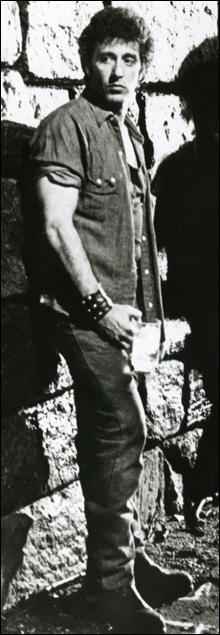|

Al Pacino in Cruising
|
On April 8, 1981, Wayne Healy, a 29-year-old gay man, was convicted of brutally murdering his former brother-in-law during a sexual encounter. After a highly problematic trial, Healy was sentenced to life without parole and remanded to MCI-Norfolk. Healy’s conviction was upheld in a series of appeals to state courts — including the Supreme Judicial Court (SJC) — until January, when US District Court Judge Michael A. Posner ruled that he should be released or retried. Not only had the state prosecutor used a blatantly homophobic strategy that emphasized a “homosexual element to the murder,” argued Posner, but the state also suppressed (either intentionally or not) vital evidence that no sexual encounter had taken place. On May 5, the US Court of Appeals for the First Circuit will hear arguments in Wayne Blyth Healy v. Luis Spencer (the Superintendent at Norfolk who, by law, must be named as the state’s respondent). This is Healy’s last chance at vindication.
The big arrow in the quiver of Healy’s lawyer, Wendy Sibbison, is a relatively new legal tactic that uses historical and literary scholarship to help judges and juries better understand how the culture of the past influenced courtroom decisions. In Healy’s case, this means explicating how deeply ingrained homophobic attitudes, psychological theories, and even popular culture — including Hollywood films like Cruising and Deliverance — played a major role in sentencing a potentially innocent man to life in prison.
The case in question
At around 1:30 am on August 8, 1980, Richard Chalue, 29, was found dead in his Holyoke apartment. Because he was in his bedroom, his pants around his knees, gagged with socks, his hands tied behind his back, the police immediately assumed, even before Healy was a suspect, that this was “a homosexual related homicide.” Healy, the victim’s former brother-in-law, had visited Chalue at 9 pm for a few minutes but returned to the home he shared with his lover, George Roy, by 12:10 am. Although there was no ill will between the two men, no physical evidence linking Healy to the crime, and no proof that Chalue was gay or bisexual, Holyoke police began to piece together a scenario in which Healy violently murdered Chalue during a sexual tryst. This fanciful plot began to seem more reasonable after Healy, a licensed practical nurse and EMT who was closeted at the time, did not tell the police that he had visited two gay bars after leaving Chalue and before arriving home, leading them to believe he was at Chalue’s apartment longer than he had stated.
During the trial, John St. Clair, the assistant district attorney for Hampden County, introduced circumstantial evidence that Healy was the murderer: a small two-day-old cut on the defendant’s hand, a statement by Chalue’s girlfriend that their sex life had been dwindling, and posed photographs of Chalue’s corpse that emphasized his naked buttocks to reinforce the suggestion that anal sex had occurred. When faced with the fact that Healy had no blood on his clothes — Chalue’s bedroom was splattered with his blood — St. Clair argued that the defendant had been naked when he committed the murder.
Not introduced at trial — and discovered only in 1999 — were the findings of Dr. H. Paul Wakefield, the chief pathologist at Holyoke Hospital who performed Chalue’s autopsy. Wakefield had found no evidence that any sexual activity had taken place. Also withheld was a memo by Wakefield stating that, even before Healy was a suspect, the Holyoke police were convinced that Chalue’s murder was connected to dangerous and deviant gay sex. Given the lack of solid evidence, motive, and even opportunity (the undisputed claim that neighbors heard Chalue scream at 1:20 am), the prosecution pushed the view that Healy was a homosexual and that, well, homosexuals are violent deviants who murder their sexual partners. In his closing arguments, St. Clair showed photos of the naked, brutalized Chalue, asking, “What kind of activity was going on in that bedroom? Ask yourself that. Don’t leave your common sense at home.”
ADVERTISEMENT
 |
It took five days and more than 30 hours to reach the verdict — and the deliberations were so rocky that even the prosecution twice asked for a mistrial. Presiding judge Kent B. Smith noted that the evidence, because it was so circumstantial, should be weighed by the jury with extraordinary care. But in the end, they were persuaded by St. Clair’s homosexual-psychopath narrative.